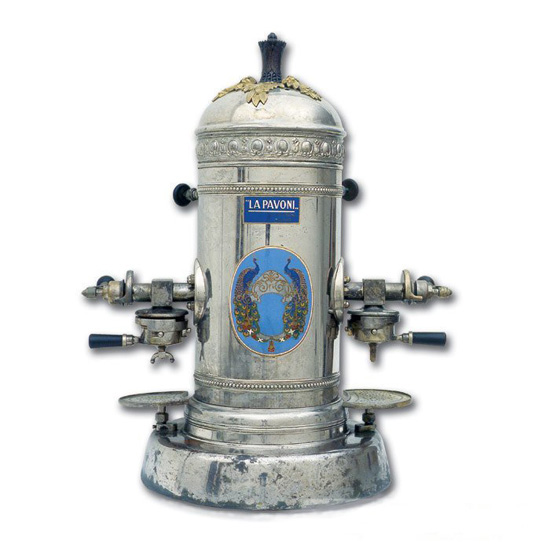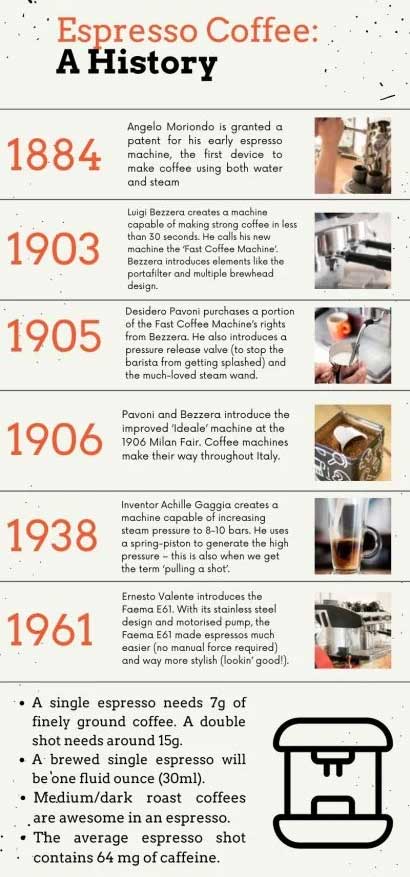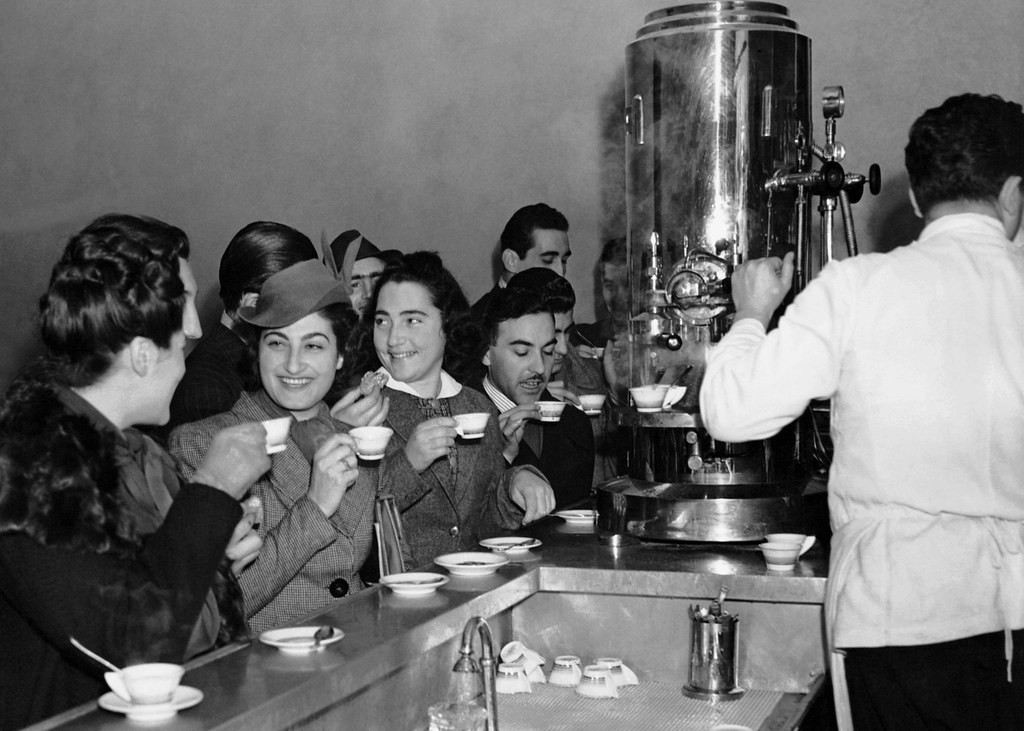The rich tapestry of the history of espresso tells a captivating story that spans centuries, tracing its origins from humble beginnings to becoming a global phenomenon. As coffee lovers crave the perfect shot, this journey reveals how espresso intertwined with Italian culture and shaped social rituals. Delving into the science of brewing and the evolution of machines, we uncover innovations that transformed coffee-drinking experiences. Join us as we explore this aromatic adventure, celebrating the artistry and passion behind every cup of espresso.
The Birth of Espresso: A Journey Through Time
The history of espresso begins in early 20th century Italy, where coffee enthusiasts sought a faster brewing method. Traditionally, coffee brewing took considerable time, leading to the invention of the espresso machine in 1901 by Luigi Bezzera. This groundbreaking device utilized steam pressure to extract rich flavors from coffee beans rapidly.
Key Milestones in the History of Espresso:
- 1901: Luigi Bezzera patents the first espresso machine, using steam pressure to create coffee quickly.
- 1938: Achille Gaggia introduces the lever espresso machine that revolutionizes espresso-making by employing a new method to create rich crema.
- 1947: The modern electric espresso machine debuts, marking a shift in coffee culture globally.
Espresso soon became a beloved symbol of Italian coffee culture. People flocked to cafés, where baristas expertly brewed this concentrated coffee, nurturing social interactions and community bonding. The rich, intense flavor of espresso not only captured the hearts of Italians but also spread internationally, paving the way for a variety of espresso-based drinks such as cappuccinos and lattes.
Thus, the history of espresso is not merely a timeline of inventions; it reflects a deep-rooted cultural phenomenon, linking tradition with modern innovation, and continues to evolve as coffee lovers worldwide embrace its rich legacy.
Espresso and the Italian Culture
The history of espresso is deeply intertwined with Italian culture, reflecting the nation’s passion for coffee and social interaction. Espresso, a concentrated coffee beverage, originated in Italy in the early 20th century and quickly became a symbol of Italian identity. Here’s how it shaped the cultural landscape:
- Social Hub: Espresso bars became gathering places for locals. Here, conversations flowed as freely as the coffee itself, creating a community atmosphere vital to Italian daily life.
- Rituals and Traditions: Italians embraced the practice of savoring their coffee, contributing to a rich espresso culture. The act of drinking espresso is often quick, yet deeply enjoyed – a true Italian ritual.
- Culinary Pairings: Espresso complements Italian cuisine beautifully. From pastries to gelato, Italians often enjoy their espresso with a sweet treat, enhancing the flavor experience.
- Art of Preparation: Traditional methods of making espresso are revered as an art form. Many Italians take pride in mastering the craft of brewing the perfect shot.
Thus, the history of espresso reflects not just a beverage but a lifestyle, underscoring its status as a fundamental element of Italian culture. It encapsulates connection, heritage, and the joy of everyday moments, making espresso much more than a simple coffee drink.
The Science Behind the Perfect Brew
Understanding the history of espresso requires delving into the science that transforms simple ingredients into a caffeine masterpiece. Several critical factors contribute to brewing the perfect cup of espresso:
- Water Temperature: Optimal brewing occurs between 190°F and 205°F. This range ensures that coffee solubles extract effectively, enhancing both flavor and aroma.
- Pressure: Traditional espresso machines use around 9 bars of pressure, allowing water to flow through the finely-ground coffee. This pressure is crucial for creating the lovely crema on top—a hallmark of a well-extracted espresso.
- Grind Size: The grind must be fine but not too powdery. A perfect grind allows for an ideal extraction time of 25 to 30 seconds, balancing bitterness and acidity—a central aspect of the history of espresso.
- Coffee-to-Water Ratio: Generally, a 1:2 ratio (for every gram of coffee, use two grams of water) is recommended. This ensures a rich and satisfying brew, essential in any discussion of espresso mastery.
- Freshness: The freshness of the coffee beans affects flavor significantly. Ideally, use beans within two weeks of roasting to capture the robust flavors that define the history of espresso.
Each of these components plays an essential role in creating that perfect shot that espresso aficionados adore, highlighting both the artistry and science woven throughout the history of espresso.
Espresso Machines: Evolution and Innovation
The history of espresso would be incomplete without a deep dive into the remarkable evolution of espresso machines. These machines have transformed decisively from humble beginnings to sophisticated brewing systems used worldwide today.
Key Milestones in Espresso Machine Development:
- 1800s: The inception of espresso machines began in Italy, with inventions like the first steam-driven coffee machines.
- 1901: Luigi Bezzerra introduced the first espresso machine capable of making coffee using steam pressure, setting the stage for future innovations.
- 1947: The introduction of the E61 group head revolutionized espresso brewing by allowing for better temperature stability and consistency.
- 1970s-1980s: Technological advancements led to the development of automatic and semi-automatic machines, making espresso more accessible to the masses.
Features of Modern Espresso Machines:
- Pressure Control: Precision in pressure allows consistency in every cup.
- Temperature Regulation: Ensures optimal extraction for the best flavor.
- User Interfaces: Intuitive controls make it easier for anyone to brew an excellent espresso.
Comparison of Espresso Machine Types:
| Machine Type | Pros | Cons |
|---|---|---|
| Manual | Full control over the brewing process | Requires skill and practice |
| Semi-Automatic | Balanced control and convenience | Still requires user input |
| Fully Automatic | Ease of use; perfect for beginners | Less control over brewing |
The evolution of espresso machines reflects the rich history of espresso, showcasing innovation in coffee technology that enhances our daily rituals.

From Café to Home: The Rise of Espresso Machines
The history of espresso has not only shaped café culture but also transformed personal brewing habits. Over the past few decades, espresso machines have transitioned from commercial marvels to beloved kitchen companions. This shift allows coffee enthusiasts to enjoy café-quality espresso in the comfort of their homes.
Key Factors in the Rise of Home Espresso Machines:
- Affordability: Initially, espresso machines were expensive and intricate. However, as technology progressed, affordable options emerged, making it easier for consumers to enter the world of espresso.
- User-Friendly Designs: Modern espresso machines come equipped with intuitive interfaces, allowing anyone – from beginners to experts – to brew delicious shots without requiring barista training.
- Diverse Options: Manufacturers have produced a variety of machines, catering to different preferences:
- Manual machines: Favor hands-on aficionados seeking precision.
- Semi-automatic machines: Balance control with convenience.
- Fully automatic machines: Perfect for those looking for simplicity.
- Increased Interest in Coffee Culture: More people are exploring the craft of espresso-making at home, motivated by social media and an appreciation for artisanal coffee.
In summary, the rise of espresso machines in households reflects the broader history of espresso. It demonstrates how coffee culture has evolved, making specialty brews accessible to everyone, stimulating a global passion for espresso right in our kitchens.
Espresso and Espresso-Based Drinks
The history of espresso extends beyond just a strong cup of coffee; it encompasses a delightful array of drinks that have become staples in coffee culture. Understanding these delicious espresso-based creations allows us to appreciate the artistry involved in each sip. Here’s a brief overview of popular espresso drinks:
- Espresso: The foundation of all coffee beverages, it’s a concentrated shot served in small amounts.
- Americano: A shot of espresso diluted with hot water, creating a smooth and rich flavor.
- Latte: A blend of espresso and steamed milk, topped with a frothy layer of milk foam—perfect for those who enjoy creaminess.
- Cappuccino: Equal parts espresso, steamed milk, and milk foam, offering a bold yet balanced experience.
- Macchiato: A shot of espresso ‘stained’ with a dollop of foam, for those who prefer a stronger coffee taste.
Comparison Table of Espresso Drinks
| Drink | Ingredients | Taste Profile |
|---|---|---|
| Espresso | 1 shot of espresso | Bold and intense |
| Americano | Espresso + hot water | Smooth and balanced |
| Latte | Espresso + steamed milk | Creamy and mild |
| Cappuccino | Espresso + steamed milk + foam | Rich and fluffy |
| Macchiato | Espresso + a touch of foam | Strong with subtle sweetness |
As you dive into the history of espresso, you uncover how each drink reflects regional preferences and cultural practices, showcasing the versatility of espresso as an essential ingredient in coffee artistry.
Global Influence: Espresso Around the World
The history of espresso unveils not just a drink but a global culture. From its Italian roots, espresso has traveled far and wide, influencing coffee traditions across continents. Here are some key points illustrating its global reach:
- Italy: The birthplace of espresso, where it became an integral part of daily life. Espresso bars serve as social hubs.
- United States: In the 20th century, espresso gained popularity as coffee shops emerged. Today, it’s the foundation of beloved beverages like lattes and cappuccinos.
- Australia: The Australian café scene embraces espresso with a unique twist. Flat whites, featuring velvety microfoam, highlight regional innovations in espresso preparation.
- Japan: A rising coffee culture has put espresso in the spotlight. Japanese baristas blend traditional techniques with modern flair, showcasing espresso through artful presentations.
- Brazil: As one of the world’s largest coffee producers, Brazil celebrates espresso in its various forms, infusing local flavors and methods into this classic drink.
The history of espresso illustrates that this rich, robust beverage adapts to local preferences, blending seamlessly into diverse coffee cultures. Its claims to fame include fostering community gatherings and inspiring creativity among baristas worldwide. This brainchild has indeed brewed a sense of unity among nations, all while seducing coffee lovers with its incomparable flavors.

Cultural Rituals: Espresso in Daily Life
Espresso isn’t just a beverage; it’s an integral part of daily life, particularly in Italian culture. The history of espresso reveals how this rich, concentrated coffee has woven itself into numerous social rituals. Let’s explore some of the cultural practices that revolve around this beloved drink:
- Morning Kickstart: Italians often begin their day with a quick shot of espresso. It’s a simple yet energizing ritual, setting the tone for a productive day.
- Midday Break: The “caffè sospeso” tradition, where patrons pay for a cup of espresso that someone else can enjoy later, fosters a sense of community.
- Social Interactions: Espresso serves as a catalyst for conversations. Friends gather in cafés to sip their espressos and share life’s ups and downs, reinforcing social bonds.
- After Meals: Espresso acts as a digestive aid. Many Italians indulge in a strong shot following meals, convinced it helps with digestion.
As the history of espresso illustrates, these rituals are not merely about drinking coffee but celebrating connection, hospitality, and Italian culture itself. Even as espresso grips the world, its cultural significance remains a distinctive element of daily life, encouraging connection over every cup.
The Future of Espresso: Trends and Innovations
As we sip our morning espresso, it’s fascinating to consider what lies ahead in the history of espresso. The journey of espresso continues to evolve, embracing not only tradition but also innovation. Here are some notable trends shaping the future of this beloved beverage:
- Sustainability: As consumers become more environmentally conscious, coffee producers are adopting sustainable farming practices. This trend aims to ensure high-quality beans while minimizing environmental impact.
- Smart Technology: Espresso machines are increasingly incorporating smart features, such as app connectivity and customizable brewing settings. This innovation allows enthusiasts to fine-tune their brew remotely, enhancing convenience and precision.
- Alternative Ingredients: Expect to see a rise in innovative espresso-based drinks that incorporate alternative milks and unique flavorings. This trend caters to diverse dietary preferences and expands taste experiences.
- Cold Brew Innovations: Cold espresso blends are gaining popularity, giving rise to refreshing drinks like the espresso tonic. This trend reflects the demand for versatility and chilled options throughout the year.
- Health Focus: Consumers are leaning toward healthier choices, prompting coffee brands to highlight the health benefits of espresso, including antioxidants and its low-calorie nature.
The history of espresso unfolds continuously, driven by these dynamic trends and innovations. As we embrace the future, there’s no telling what delightful possibilities await espresso lovers!
Espresso Myths Debunked
The history of espresso is rich with fascinating tales, but it also comes with its fair share of myths and misconceptions. Let’s clear the air on some commonly held beliefs about this beloved drink:
- Myth 1: Espresso has more caffeine than brewed coffee.
- Fact: Although espresso is stronger in flavor, it typically contains less caffeine per serving. An ounce of espresso has about 63 mg of caffeine, whereas a standard 8-ounce cup of brewed coffee has around 95 mg.
- Myth 2: Espresso is just dark coffee.
- Fact: The history of espresso reveals that it’s a unique brewing process that involves forcing hot water through finely-ground coffee. This distinctive method results in a concentrated shot of coffee that’s different from just brewing coffee longer.
- Myth 3: All espresso drinks are loaded with sugar and milk.
- Fact: Many people enjoy espresso straight, savoring its rich, bold flavor without any additives. While espresso serves as the base for various drinks, the essence lies in its pure form.
- Myth 4: Espresso is only for Italians.
- Fact: While Italy popularized espresso, its appeal transcends borders. Today, the history of espresso reflects global influences, incorporating diverse cultures and preferences.
By debunking these myths, we can appreciate the true nature of espresso and celebrate its rich legacy in coffee culture.

Frequently Asked Questions
What is the origin of espresso?
Espresso traces its roots back to the early 20th century in Italy, where a revolutionary brewing method was developed. The first espresso machine was created by Luigi Bezzera in 1901, aimed at producing coffee quickly and efficiently. This innovative technique sparked widespread popularity, leading to the proliferation of espresso bars across Italy. Over the decades, espresso became the cornerstone of Italian coffee culture, influencing coffee trends globally.
How is espresso different from regular coffee?
Espresso and regular coffee differ mainly in their brewing methods and flavor profiles. Espresso is made by forcing hot water through finely-ground coffee beans, resulting in a concentrated and rich beverage with a robust flavor and a layer of crema on top. In contrast, regular coffee is typically brewed using a drip or pour-over method, which tends to produce a milder taste. Espresso serves as the base for various coffee drinks, including lattes, cappuccinos, and Americanos.
What types of coffee beans are used for espresso?
Espresso can be made from a variety of coffee beans, but the most commonly used types are Arabica and Robusta. Arabica beans are known for their smooth, nuanced flavors, while Robusta beans provide a stronger, more bitter taste and higher caffeine content. Many espresso blends contain a mix of both bean types, striking a balance between flavor richness and intensity. The selection of beans greatly impacts the final taste of the espresso shot.
How do you make a perfect espresso at home?
To craft a perfect espresso at home, you’ll need a quality espresso machine, freshly ground coffee, and a tamper. Start by using high-quality, freshly roasted beans, ideally ground just before brewing. Measure roughly 18-20 grams of coffee grounds, evenly distributing them in the portafilter. Use the tamper to compress the grounds firmly. Attach the portafilter to your machine, and extract the espresso for about 25-30 seconds. The result should be a rich, thick shot with a golden crema on top.
What are some popular espresso-based drinks?
There are many delightful espresso-based drinks that have captured coffee lovers’ hearts around the world. The classic espresso shot serves as the foundation for drinks like the velvety cappuccino, made with equal parts espresso, steamed milk, and microfoam. Lattes, characterized by their creamy texture, contain more steamed milk. For a bolder experience, the Americano mixes espresso with hot water. Additionally, drinks like macchiatos and mochas add their unique twists, making espresso a versatile favorite in cafés.
